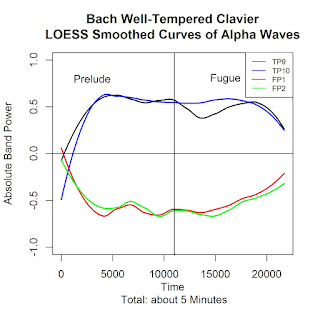What is a Fugue?
Creator's Project blog. The visualization powerfully contrasts the relative simplicity of the prelude to the complexity of the 4-voice fugue. It highlights the complexity of the fugue better than other computer-based visualizations, in my opinion, because the fugue is visualized in three dimensions. All four voices are clearly distinguished.
Considering my earlier post about the mystical experience in Bach's music, I began to think about how listening to fugues affects our minds. In particular, I conjecture that meditation on fugues can be a powerful exercise of concentration and mental visualization that leads to higher states of awareness. To investigate this conjecture, I use a wearable EEG to assess whether preludes can calm the mind and whether fugues can focus the mind.
Below, watch as the mellow and sweet prelude changes to the complex fugue for 4 voices. The brain waves show markedly different patterns across the two musical movements. During the prelude, there is suggestive evidence of a very relaxed state of mind, with high alpha waves and decreasing beta and gamma waves. Once the fugue begins, however, the beta and gamma waves shoot up at a steady pace. The alpha, theta, and delta waves remain roughly constant. Together, these patterns suggest that focus is increasing while calm awareness is maintained. Please note that I use the word "suggest" since the analysis of EEG brain waves is very complex, and my cursory reading of online popular writings offers only general ideas about alpha, beta, theta, delta, and gamma waves. However, subjectively, I can confirm that I felt calm and then focused and aware.
A good summary of brain activity and meditation is here from Bryan Williams, but I cannot vouch for its accuracy. It includes interesting findings from research on contemplative nuns, but the summary is more general:
There are five types of brain waves that are distinguished by their frequency, measured in cycles per second, or Hertz (Hz): Delta waves (1 – 3 Hz) have the slowest wave cycles, and commonly appear when we are in a deep sleep. Theta waves (4 – 7 Hz) can also be present during sleep, usually when we start to feel drowsy and fall into a light sleep (Carlson, 1992, pp. 242 – 243). Alpha waves (8 – 12 Hz) are typically present during a state of relaxed awareness, when our minds are not actively engaged in deep thought. Beta waves (13 – 29 Hz) appear when we are actively thinking, alert, and attentive (Schneider & Tarshis, 1995, pp. 412 – 413). Gamma waves (30 – 80 Hz) have the fastest wave cycles, and often arise when we are mentally integrating and processing complex sensory information (Desmedt & Tomberg, 1994; Joliot et al., 1994).
Perhaps a new meditation exercise can be the Bach WTC Meditation: an intense period of meditation on every prelude and fugue in the WTC Book 1 or 2. You train your mind to relax during the preludes, and focus and visualize during the fugues. I suspect that you would reach a powerful mental state by the end of the recording. Once you reach the level of master, you progress to the Art of the Fugue.
______________________________
The Well-Tempered Clavier
Beta waves (13 – 29 Hz) appear when we are actively thinking, alert, and attentive (Schneider & Tarshis, 1995, pp. 412 – 413).
Delta waves (1 – 3 Hz) have the slowest wave cycles, and commonly appear when we are in a deep sleep.
Watch the entire video here.
UPDATE 6/21/2015
Most of the changed activity is in the frontal lobes of the brain. In the figures below, the lines with "TP" represent the EEG sensors at the temporal poles by the ears, while the "FP" lines represent the sensors at the front of the head. Prelude is left half (1 - 11000) on the x-axis, and the Fugue is the right half (11001 - end).









No comments:
Post a Comment